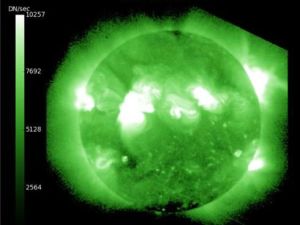
Courtesy of NOAA
I’ll be honest—I don’t pay close attention to space weather. I’m busy enough trying to figure out how scared I should be—and how scared I should make you—of regular old Earth weather, like hurricanes, floods and droughts.
But maybe I should start keeping tabs on what’s going on above us. On September 24 the sun unleashed a strong solar storm—an outburst of energy known as a coronal mass ejection that sent a massive cloud of plasma and magnetic energy hurting through space and toward the Earth at 5 million mph. The edges of that energy struck the planet on September 26, producing a medium-size solar storm—a G3 on the National Oceanic and Atmospheric Administration’s Space Weather Prediction Center (SWPC) five-point scale.
If solar storms are like space hurricanes—close enough—the planet received the equivalent of a glancing blow, enough to cause some possible minor problems with satellite communications and GPS, but nothing most of us would have noticed. But we were lucky. Serious space weather—the catch-all term for sun’s unusual activity—has the potential to ruin the electrical grid, disrupt air travel, knock out satellites for years and generally send our high-tech society back to the 18th century. “There’s a belief that as we build a society that depends more on technology we become more vulnerable to space weather,” says Doug Biesecker, a physicist with the SWPC.
More from TIME: NASA Images the Entire Sun
First a little space weather primer. Solar activity works on an 11 year-cycle, with solar flares and eruptions occurring hundreds of times throughout the cycle. Most such solar flares are harmless, but occasionally the sun will experience a coronal mass ejection of the sort seen on September 24. Those events send highly magnetized atomic particles (plasma) towards the Earth, and are often visible from high latitudes in the form of spectacular auroras. If that plasma collides with the Earth, it can trigger geomagnetic storms—spikes in electrical currents in the atmosphere and on the ground created by the interaction between the Earth’s magnetic field and the plasma. The effects tend to be amplified near the poles, where the Earth’s magnetic field is weakest.
The strongest solar storm in recorded history occurred in 1859, and it’s called the Carrington Event, named after the British astronomer David Carrington, who witnessed the massive solar flare. Telegraph transmitters heated up—the wire caught the wave of solar energy—and some even burst into flames. But that was 1859, before the electrical grid, before GPS and cell phones—before the development of all the technology that we now need that is vulnerable to magnetic energy. If a similarly strong solar storm were to hit the planet today, the results would be far different—and far more catastrophic. A 2008 National Academy of Sciences study (NAS) projected that an Carrington-level solar storm could knock out electricity to parts of the northeastern and northwestern U.S. for months or even years.
More from TIME: Brief History: The Sun
Brian Verstag, in a recent Washington Post story on the threat of space weather, sketches out the rest of the grim scenario:
Report co-author John Kappenmann estimated that about 135 million Americans would be forced to revert to a pre-electric lifestyle or relocate. Water systems would fail. Food would spoil. Thousands could die. The financial cost: Up to $2 trillion, one-seventh the annual U.S. gross domestic product.
Scary stuff. Utilities have argued that the NAS study overstates the threat from space weather, but much smaller solar flares have still caused problems with the grid in recent years. The good news is that we do have a way to predict space weather before it hits. The SWPC is a 24/7 operation that monitors the sun for any abnormalities, looking for tipoffs like a sudden surge in solar X-rays. The SWPC also makes use of coronagraphic equipment included aboard NASA’s Advanced Composition Explorer (ACE) satellite which enables scientists to monitor what is going on inside the sun’s corona, the plasma atmosphere around the sun. When a coronal mass ejection event occurs, the SWPC can see it as it happens. “We want to make sure there’s nothing out there that’s going to surprise us,” says Beisecker. “It’s just like seeing a hurricane beginning to from off the coast of Africa and being able to predict it.”
Photos from TIME: 3-D Photos of the Sun
In the case of the September 24 solar storm, SWPC was able to warn airlines and utilities before the storm reached the Earth. The SWPC posted a YouTube video modelling the solar storm:
[youtube=http://www.youtube.com/watch?v=YUhqXU1KpZ0&feature=player_embedded]
It’s not a perfect system—experts compare it to weather forecasting in the 1950s—but it keeps us from flying blind through space. The only problem is that we may be losing our eyes—the ACE satellite is nearly 15 years old and gradually failing. NOAA has requested a replacement for ACE in the 2011 budget, but that’s been stalled thanks to Congressional deadlock. “Getting a replacement for ACE is very important,” says Beisecker—because if that satellite goes, our space weather prediction system will be crippled. We got off light with the solar storm this time, but our luck will run out eventually—and possibly quite soon, because the current solar cycle is set to peak over the next couple of years. A “Space Katrina” could be inevitable—at the very least we should be able to see it coming.
More from TIME: How the Heat Wave Is Stressing Out the Electrical Grid
Bryan Walsh is a senior writer at TIME. Find him on Twitter at @bryanrwalsh. You can also continue the discussion on TIME’s Facebook page and on Twitter at @TIME.


